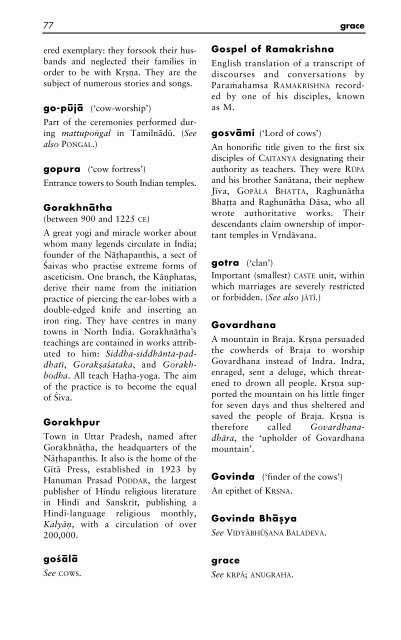A Concise Encyclopedia of Hinduism Klaus K Klostermaie
Create successful ePaper yourself
Turn your PDF publications into a flip-book with our unique Google optimized e-Paper software.
77 grace<br />
ered exemplary: they forsook their husbands<br />
and neglected their families in<br />
order to be with Kø•æa. They are the<br />
subject <strong>of</strong> numerous stories and songs.<br />
go-püjä (‘cow-worship’)<br />
Part <strong>of</strong> the ceremonies performed during<br />
mattupoögal in Tamilnãdü. (See<br />
also PO¢GAL.)<br />
gopura (‘cow fortress’)<br />
Entrance towers to South Indian temples.<br />
Gorakhnätha<br />
(between 900 and 1225 CE)<br />
A great yogi and miracle worker about<br />
whom many legends circulate in India;<br />
founder <strong>of</strong> the Näflhapanthis, a sect <strong>of</strong><br />
Ÿaivas who practise extreme forms <strong>of</strong><br />
asceticism. One branch, the Käæphatas,<br />
derive their name from the initiation<br />
practice <strong>of</strong> piercing the ear-lobes with a<br />
double-edged knife and inserting an<br />
iron ring. They have centres in many<br />
towns in North India. Gorakhnätha’s<br />
teachings are contained in works attributed<br />
to him: Siddha-siddhänta-paddhatï,<br />
Gorak•aÿataka, and Gorakhbodha.<br />
All teach Haflha-yoga. The aim<br />
<strong>of</strong> the practice is to become the equal<br />
<strong>of</strong> Ÿiva.<br />
Gorakhpur<br />
Town in Uttar Pradesh, named after<br />
Gorakhnäflha, the headquarters <strong>of</strong> the<br />
Näflhapanthis. It also is the home <strong>of</strong> the<br />
Gïtä Press, established in 1923 by<br />
Hanuman PrasadPODDAR, the largest<br />
publisher <strong>of</strong> Hindu religious literature<br />
in Hindï and Sanskrit, publishing a<br />
Hindï-language religious monthly,<br />
Kalyäæ, with a circulation <strong>of</strong> over<br />
200,000.<br />
goÿälä<br />
See COWS.<br />
Gospel <strong>of</strong> Ramakrishna<br />
English translation <strong>of</strong> a transcript <strong>of</strong><br />
discourses and conversations by<br />
Paraƒahamsa RAMAKRISHNA recorded<br />
by one <strong>of</strong> his disciples, known<br />
as M.<br />
gosvämi (‘Lord <strong>of</strong> cows’)<br />
An honorific title given to the first six<br />
disciples <strong>of</strong> CAITANYA designating their<br />
authority as teachers. They were RÜPA<br />
and his brother Sanätana, their nephew<br />
Jïva, GOPÄLA BHAfifiA, Raghunätha<br />
Bhaflfla and Raghunätha Däsa, who all<br />
wrote authoritative works. Their<br />
descendants claim ownership <strong>of</strong> important<br />
temples in Vøndävana.<br />
gotra (‘clan’)<br />
Important (smallest) CASTE unit, within<br />
which marriages are severely restricted<br />
or forbidden. (See also JÄTÏ.)<br />
Govardhana<br />
A mountain in Braja. Kø•æa persuaded<br />
the cowherds <strong>of</strong> Braja to worship<br />
Govardhana instead <strong>of</strong> Indra. Indra,<br />
enraged, sent a deluge, which threatened<br />
to drown all people. Kø•æa supported<br />
the mountain on his little finger<br />
for seven days and thus sheltered and<br />
saved the people <strong>of</strong> Braja. Kø•æa is<br />
therefore called Govardhanadhära,<br />
the ‘upholder <strong>of</strong> Govardhana<br />
mountain’.<br />
Govinda<br />
An epithet <strong>of</strong> KØÆŒA.<br />
(‘finder <strong>of</strong> the cows’)<br />
Govinda Bhä•ya<br />
See VIDYÄBHÜÆANA BALADEVA.<br />
grace<br />
See KØPÄ; ANUGRAHA.


















